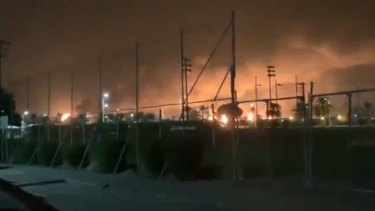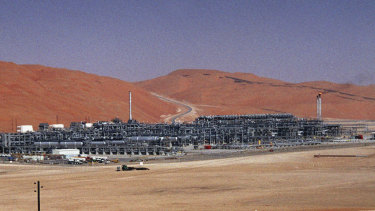
A NASA satellite image showed what appeared to be a long streak of black smoke flowing to the south-west from the Aramco site.
An Aramco statement said production of 5.7 million barrels of crude was suspended by the attack from "projectiles." That represents more than half of the kingdom's output and about 6 per cent of global oil supply - a shortfall that could send oil price sharply higher.
The Aramco statement did not give any timetable on how long the production could be curtailed. In Washington, the Department of Energy said that the United States was prepared to tap US emergency oil reserves if necessary to cover supply disruptions.

An image from a video showing explosions in Buqyaq, Saudi Arabia.Credit:Twitter/@AhmadAlgohbary
The blasts struck facilities in the districts of Khurais and Abqaiq, Saudi officials said. That is more than 500 miles from the Houthi-controlled zones in Yemen - raising critical questions about Saudi Arabia's ability to defend its territory from Houthi missile and drone attacks with an apparent expanding range.
The rebels' claim of responsibility, if confirmed, further highlighted their rapidly advancing military prowess. Saudi Arabia and the United States accuse Iran of providing the Houthis with military equipment and technical expertise, a charge Tehran has denied.
Houthi missiles have struck Saudi sites before, including its oil infrastructure. But the latest strike on Aramco was a symbolic blow against the historical hub of the kingdom's oil riches, and the centrepiece of Crown Prince Mohammed bin Salman's plans to remake the kingdom's economy.
The company is preparing an initial public offering intended to raise billions for an economic reform program championed by the crown prince to move the country away from its dependence on oil revenue.
Loading
The attacks are likely to drive up global oil prices when trading resumes after the weekend and Saudi experts assess the damage. Benchmark Brent crude was just above $60 a barrel on Friday.
In a phone call between President Donald Trump and the crown prince on Saturday, Trump "expressed his country's readiness to cooperate with the kingdom in supporting its security and stability, stressing the negative impact of the recent terrorist attacks against Aramco facilities on the American economy, as well as the global economy," according to a Saudi readout of the call.
The crown prince told Trump that Saudi Arabia is "willing and able to confront and deal with this terrorist aggression," according to the statement.
Hours later, Secretary of State Mike Pompeo directly blamed Iran for "an unprecedented attack on the world's energy supply." Pompeo, however, offered no specific evidence.
There was no immediate comment from Iranian leaders after the oil site attacks.
Khurais is one of Saudi Arabia's largest oil fields and is believed to produce about 1.5 million barrels per day. Abqaiq is the site of the kingdom's largest oil processing facility, operated by Saudi oil giant Aramco.
It may be the world's most important piece of oil infrastructure, built to process about 7 million barrels a day of oil so that it can be shipped out of the Persian Gulf to foreign markets.
Saudi Arabia produced 9.85 million barrels of oil a day in August, making up about 10 per cent of the global supply.
Videos posted online showed massive fires sending up huge plumes of smoke. Large explosions and the sounds of gunfire could be heard in some of the videos.
A statement by the Saudi state news agency said that the attacks occurred about 4 am local time and that Aramco teams had contained the fires. The statement did not say whether anyone was injured.

Aramco's Shaybah oil field in Saudi Arabia was attacked by a drone in August.Credit:AP
Saudi Arabia said it was still trying to determine who had carried out the attack, despite the Houthi claim.
Colonel Turki bin Saleh al-Malki, a spokesman for the Saudi-led military coalition fighting in Yemen, said in a statement that physical evidence was collected but that "investigations are ongoing to determine the parties responsible for planning and executing these terrorist attacks."
For years, the Houthi rebels have framed their cross-border missile and drone attacks as retaliatory and aimed at ending the Saudi military intervention, including Saudi airstrikes that have killed thousands of civilians.
The Houthi attacks, including on civilian airports and oil installations, have become more frequent in recent months, leading to Saudi accusations that Iran has prodded the rebels into opening a new military front during Tehran's worsening confrontation with regional adversaries.
The Houthis have acknowledged their alliance with Iran but denied acting on Tehran's orders. A Houthi military spokesman, quoted by the rebel al-Masirah news channel, said the group's attacks on Saudi Arabia would expand and become "more painful as long as its aggression and siege continue."
The civil conflict in Yemen began in 2014, after the Houthis seized control of Sanaa, the capital. An Arab military coalition, led by Saudi Arabia and the United Arab Emirates, intervened in the war early in 2015, with the aim of restoring the ousted Yemeni government.
The conflict has given rise to one of the world's worst humanitarian disasters and has killed close to 100,000 people, according to a recent estimate by a crisis-monitoring group. Diplomatic efforts, led by the United Nations, have repeatedly failed to halt the fighting.
The Houthis have repeatedly tried to attack Saudi oil facilities, including last month, when a rebel drone attack on the Shaybah oil field, near Saudi Arabia's border with the United Arab Emirates, caused a fire but did not result in injuries.
The strike on Abqaiq, where crude oil is processed, targeted a "vital piece" of the Saudi oil production network while exposing gaps in the kingdom's defensive capabilities, said Jean-Francois Seznec, a senior fellow at the Global Energy Center at the Atlantic Council.
The installation had been targeted before, unsuccessfully, including by al-Qaida militants more than a decade ago and more recently by the Houthis.
"Abqaiq cannot be attacked from the ground," Seznec said. "From the air, it's a little more difficult to defend."
Robert McNally, a former national security aide on energy matters for President George W. Bush, called Abqaiq "the crown jewel of the Saudi kingdom."
"No single facility comes close to importance in terms of wealth creation from the kingdom," said an email from McNally, president of the consulting firm the Rapidan Energy Group.
"Even if damage is light, the fact that Iranian proxies have attacked the crown jewel of Saudi Arabia means the overall risk level is going up."
McNally said the repair time - and the price fluctuations on the oil market - will depend on whether "unique, tailor-made" components and support systems were severely damaged. Such a scenario would mean months of work ahead and oil prices possibly spiking "toward $100 a barrel," he added.
"Abqaiq not only controls 5 per cent of oil global oil supply, but it handles nearly all of spare production capacity," he wrote.
But, he added, "If the damage is light, then crude prices may rise by only a few dollars per barrel initially."
Even though the United States produces most of its own crude oil and imports much of the rest from Canada, a jump in world prices affects all producers and consumers and will still have some impact for Americans at the pump.
Saudi Arabia can ease any shortage in oil markets for the time being by ramping up production of light, low-sulfur crude oil that requires less processing. And it can tap supplies of crude oil it keeps in storage.
But those inventories of crude oil have been dwindling, McNally said in a note to clients. Saudi Arabia has about 188 million barrels available, enough to cover Abqaiq's estimated 5 million barrel-a-day supply disruption for 37 days.
The Rapidan Energy Group cited a 2011 report estimating that the state-owned oil company Aramco could quickly reduce a disruption to about 3.5 million barrels a day - still about 3.5 per cent of the world's daily oil consumption. The company has some spare stabilization facilities.
"Until the attack, the oil market had been complacent about geopolitical risk and was even focusing on the possibility that President Trump could ease oil sanctions on Iran," McNally wrote. "The question is how much of a premium will be added to the oil price."
The Washington Post









 Add Category
Add Category